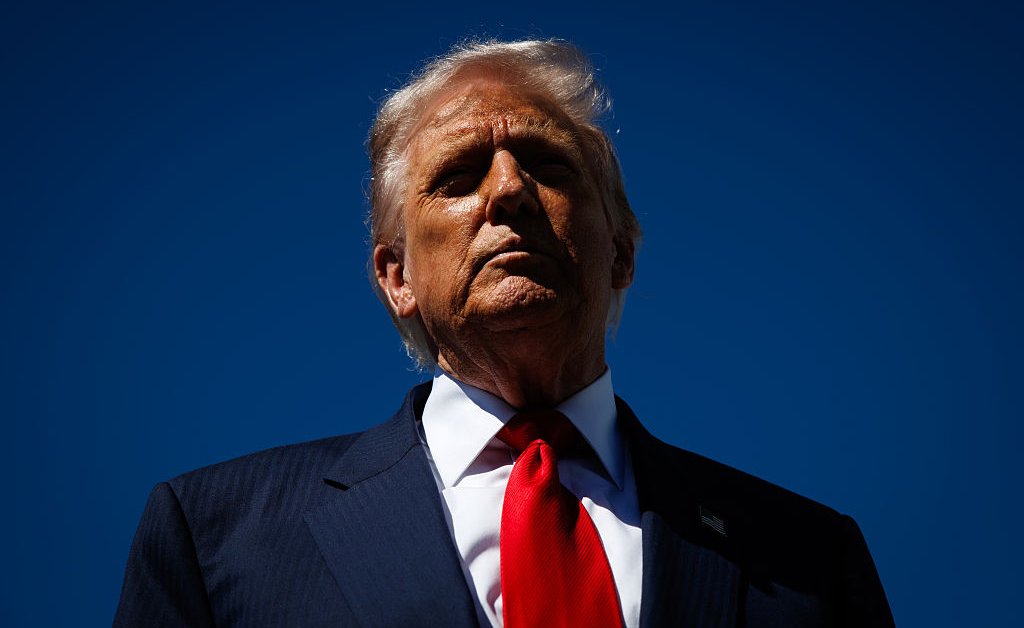A man from suburban Chicago was arrested Monday for allegedly making a threat to kill President Donald Trump.
Trent Schneider, 57, of Winthrop Harbor, Ill., was charged with “making a true threat to injure another person in interstate commerce,” according to a criminal complaint filed by the U.S. Attorney’s Office for the Northern District of Illinois, which also announced Schneider’s arrest.
The complaint alleges that Schneider posted a video of himself on Instagram on Oct. 16, 2025, in which he said, “I’m going to get some guns. I know where I can get a lot of f-cking guns, and I am going to take care of business myself. I’m tired of all you f-cking frauds. People need to f-cking die, and people are going to die. F-ck all of you, especially you Trump. You should be executed.”
The video was posted several times on the account, which remains public as of Tuesday morning. The caption, which is repeated on all the posts of the video, reads: “THIS IS NOT A THREAT!!! AFTER LOSING EVERYTHING and My House Auction date is 11.04.2025 @realDonaldTrump SHOULD BE EXECUTED!!! SHE IS A #FRAUD and a #COWARD!!! SHE CARES NOTHING ABOUT YOU or ME!!!” The account also includes several posts of an image of Trump inside a red circle with a line through it (the prohibition symbol) alongside the same text.
According to the complaint, Schneider was the defendant in a foreclosure auction scheduled for Nov. 4.
“Most of what he does, they say you’re watching a movie, but people like me have suffered real f-cking crimes from f-cking judges, doctors, lawyers, police, they all should be killed. All of them should be executed for what they’ve done,” Schneider says in the video.
The caption on the posts also refers to former President John F. Kennedy’s assassination, claiming Israel was “behind” it. It also claims the earth is “hollow” and that Schneider is the “21st Century Messiah.”
Schneider made an initial court appearance Monday afternoon before a judge in Chicago and was ordered to remain detained in federal custody pending a detention hearing on Thursday.
According to the complaint, Schneider was previously investigated and arrested in 2022 for making threats to “shoot up” a T-Mobile store but was found unfit to stand trial.
Trump was the subject of several assassination attempts last year, and his Administration has taken responding to such threats seriously.
Schneider’s threat against the President is just one of several against Trump since his second-term inauguration that federal and state authorities have acted on, but few have resulted in sentences, as the courts balance protecting the nation’s leader and constitutionally protected speech.
Here’s what to know about some of the cases.
Several threats since White House return
Federal and state authorities have arrested and charged numerous individuals for making death threats against the 47th President.
Richard James Spring from Michigan was sentenced to 18 months in prison, followed by two years of supervised release, on Oct. 20 after comments he made on X and TikTok—“I promise I will put a bullet in your head” and “I’ll kill Trump”—in January, after Trump’s inauguration.
In June, a complaint was filed against Peter Stinson, a former Coast Guard lieutenant from Oakton, Va., over posts he’s been making on microblogging platforms X and Bluesky that allegedly called for Trump’s assassination since 2020. According to prosecutors’ filings, Stinson made posts on Bluesky, including that he would “twist the knife after sliding it into his fatty flesh” and, “Can we crowd source a contract hit?” A grand jury indicted him on one count of soliciting Trump’s assassination for a February Bluesky post that read, “Take the shot. We’ll deal with the fallout.” But on Oct. 28, a grand jury acquitted him after his lawyers argued that what he said was constitutionally protected free speech.
In August, Nathalie Rose Jones was arrested over comments she posted on Facebook and Instagram, including: “I am willing to sacrificially kill this POTUS by disemboweling him and cutting out his trachea with Liz Cheney and all The Affirmation present.” The Justice Department said the Secret Service interviewed Jones twice: in the first, Jones had reportedly said “that if she had the opportunity, she would take the President’s life and would kill him at ‘the compound’ if she had to;” in the second, she denied that she had any present desire to harm Trump. In September, grand jurors in Washington, D.C., declined to indict her.
Also in August, Edward Alexander Dana, who was arrested on vandalism charges, was accused of threatening the President while in police custody. He allegedly said: “I’m not going to tolerate fascism…. And that means killing you, officer, killing the President, killing anyone who stands in the way of our Constitution…” But grand jurors also declined to indict him, with Dana’s lawyer Elizabeth Mullin telling the Associated Press that prosecutors are bringing “weak cases” to court and “the grand juries are seeing through it.” She added: “It’s a huge waste in resources.”
Joshua Levi Young, who served for 1 ½ years in the U.S. Air Force before his discharge in January 2024, was arrested late last month after allegedly posting messages threatening to kill Trump across his social media accounts. One Instagram post reportedly read: “I am going to kill trump raise him from the dead and kill him again.” Young’s case is ongoing.
Also in October, Derek Lopez was arrested and charged with threatening to kill the President on social media. The government affidavit said Lopez posted a video of a man holding up a gun before a picture of Trump with a crosshairs target illustrated on his head appeared on screen. And on X, Lopez allegedly posted: “I’m gonna kill Donald Trump, idaf.” That case is also ongoing.
The complex legal landscape of death threats
Threatening the U.S. President is a federal felony under Title 18 of the U.S. Code Section 871(a). Under that statute, it is a federal crime to “knowingly and willfully” make “any threat to take the life of, to kidnap, or to inflict bodily harm upon the President of the United States.” The statute carries a maximum penalty of five years imprisonment and a $250,000 fine.
But with the clause hinging on speech, courts have, over history, tried to bring more nuance in order to maintain a delicate balance between protecting the President and the First Amendment. The Supreme Court’s decision in Watts v. United States sets a foundation for distinguishing protected political speech from “true threats” against the President. That ruling said that political hyperbole does not constitute a true threat to the President.
The 2003 case Virginia v. Black defined “true threats” as “statements where the speaker means to communicate a serious expression of an intent to commit an act of unlawful violence to a particular individual or group of individuals,” adding that “the speaker need not actually intend to carry out the threat.”
“True threats” were further defined in a 2023 Supreme Court ruling in Counterman v. Colorado. The court held that to convict a person of making true threats, it must be proven that the speaker had a subjective understanding as to whether the intended recipients of the statements perceive them as threatening.
But a memo from the Middlebury Institute of International Studies at Monterey on true threats against the President and local officials says that “threats that fall outside the boundaries of ‘true threats’ under the First Amendment may still warrant law enforcement attention and should be reported.”
U.S. Attorney for Washington, D.C., Jeanine Pirro, slammed juries for becoming “politicized” after the refusal to indict in a case her office pushed regarding Jones.
“A Washington D.C. grand jury refused to indict someone who threatened to kill the President of the United States. Her intent was clear, traveling through five states to do so,” Pirro told Fox News. “She even confirmed the same to the U.S. Secret Service. This is the essence of a politicized jury. The system here is broken on many levels. Instead of the outrage that should be engendered by a specific threat to kill the president, the grand jury in D.C. refuses to even let the judicial process begin. Justice should not depend on politics.”
Jen Golbeck, a University of Maryland professor studying extremism on social media, testified at Stinson’s trial as a defense witness. She told the Washington Post that, while she doesn’t encourage posting violent thoughts on social media, she was surprised to see Stinson charged with a federal crime for posting what she says was a “common” sentiment.
“There’s a lot of people online rooting for Trump to die,” Golbeck said, “and in that context, what he posted is so common that it feels like an alternate universe that he would be charged with anything, let alone solicitation of murder.”
The post Man Arrested for Threatening Trump on Instagram: What to Know appeared first on TIME.




